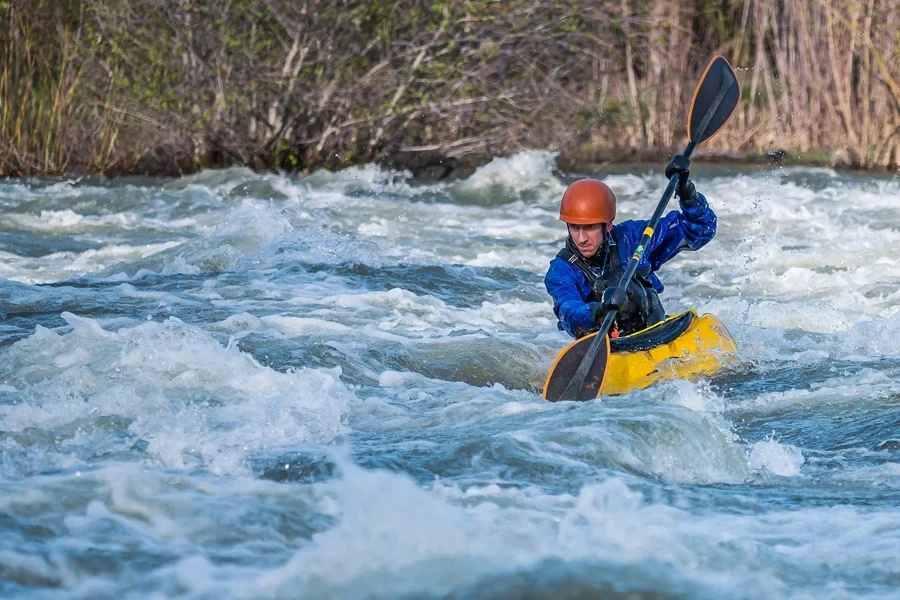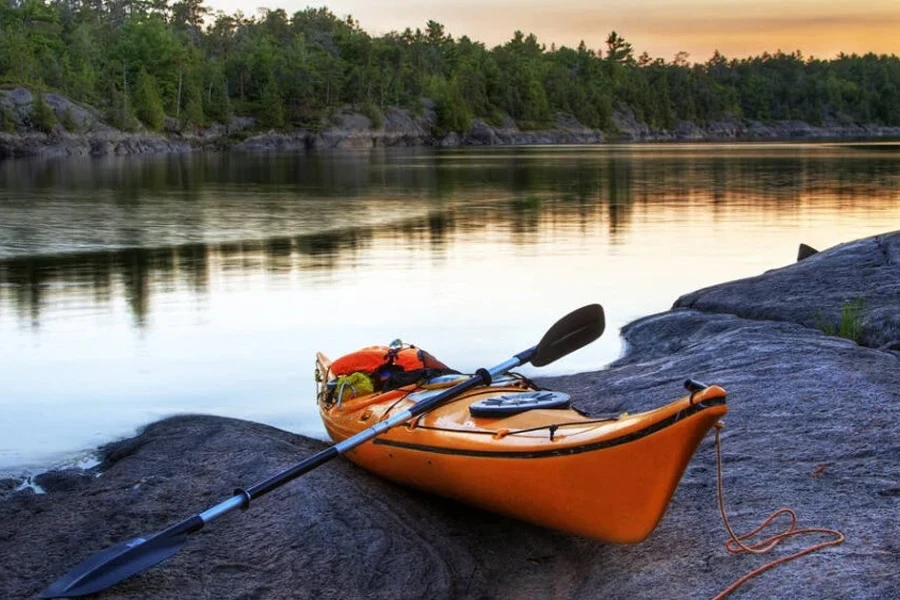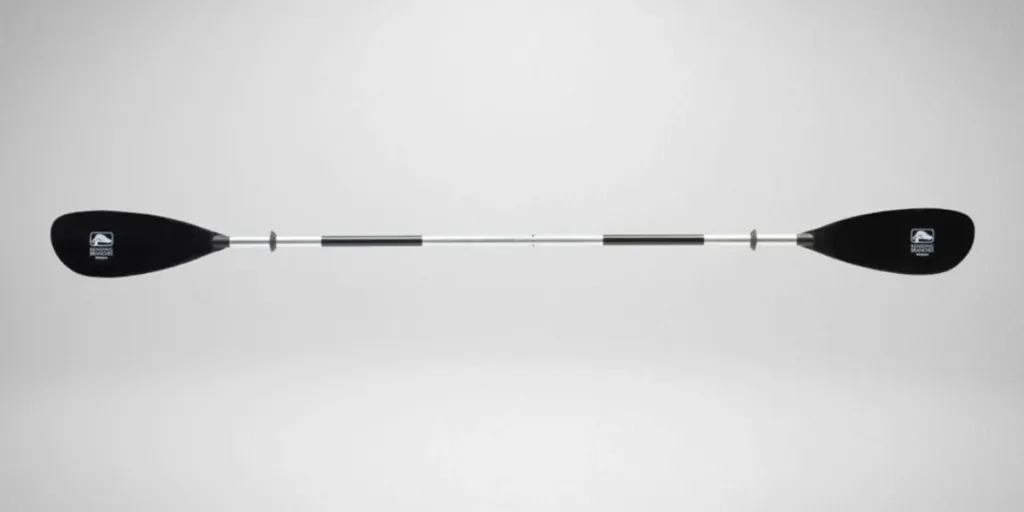Most consumers turn to kayaking as a great, beginner-friendly way to enjoy watersports. And one thing that’s absolutely necessary for this activity is kayak paddles. However, choosing them goes beyond picking a tool with two blades that help consumers propel through the water.
Since kayakers perform thousands of strokes per hour, offering quality paddles based on this can help ensure consumers get a thrilling experience! From paddle construction materials to sizing, here is what sellers need to know before selling paddles in 2024.
Table of Contents
Overview of the kayak paddle market
Everything to look at before stocking up on kayak paddles
Rounding up
Overview of the kayak paddle market

The global kayak accessories market was valued at US $164.2 million in 2020. Experts expect it to climb even higher, reaching an impressive US $214 million by 2027 at a 3.9% compound annual growth rate (CAGR) over the forecast period. The market is registering outstanding growth due to the rising popularity of kayaking worldwide.
Other factors positively impacting the market include the rising adoption of kayaking as a recreational activity, increasing awareness of the fitness benefits associated with the sport, and surging interest in outdoor sports. Paddles emerged as the top segment in the kayak accessories market, accounting for a major share of the global revenue. North America is also the dominant regional market due to a robust outdoor recreation culture and the prevalence of water sports.
Everything to look at before stocking up on kayak paddles
Construction materials
Materials determine the quality of kayak paddles. Manufacturers can use up to five different construction materials when making their paddles. Take a closer look at each of them below:
Aluminum paddles
These are the most budget-friendly options. Sturdy and reliable, aluminum paddles are perfect if consumers are dipping their toes into kayaking or only occasionally hitting the water. But here’s the deal: when the weather’s chilly, those shafts can feel pretty darn cold, and their weight might not make them the top choice for a long-haul tour compared to lighter carbon fiber or fiberglass paddles.
Plastic paddles
These paddles are everywhere, mainly because they are tough as nails and won’t break the bank. Another big plus for plastic paddles is their low-maintenance nature. However, consumers will definitely notice these paddles are heavier than their fiberglass and carbon cousins.
Now, here’s the flip side: plastic paddles usually have chunkier edges and a bit more bend, which can make strokes less efficient. For that reason, they are only solid picks for casual paddlers, chilling at the cabin, quick day trips, or just keeping around as a backup.
Carbon fiber paddles
Carbon fiber is the king of kayak paddle materials. These paddles are top-notch but come with a high price tag to match. Regardless, they have many benefits that make them worth the investment. Here’s the lowdown: they are crazy light, seriously sturdy, and as stiff as they come.
For this reason, carbon fiber paddles are perfect for those epic marathon kayak tours where consumers need every advantage they can get. Plus, bonus points for the shaft feeling warm and cozy in the hands compared to chilly aluminum paddles.
Fiberglass paddles
These paddles are like the Goldilocks of kayaking gear: not too heavy, not too flimsy, just right. They are extremely light and stiff, but they are also built to last. That’s why fiberglass paddles are the go-to for folks who love kayak touring or just cruising around for fun. And if consumers are looking for something in the middle of the road, blades made of fiberglass with carbon shafts strike a good balance between weight, toughness, and cost.
Wooden paddles
People who love wooden paddles are all about that classic vibe. But even traditional wood comes with a few extra perks. For starters, wooden paddles offer a bit more flex, which some paddlers swear by, along with cozy warmth consumers don’t get with other materials.
But here’s the trade-off: they need a little TLC, like sanding and varnishing now and then, to keep them in top shape. Wooden paddles are not the lightest option out there, but they are not too heavy either, landing somewhere in the middle. And the price? Well, that depends on the type of wood consumers are after.
Paddle blade shapes
Paddle blade shapes are crucial because they determine how consumers move through the water with each stroke. This blog reveals the top four options. Check them out below.
High-angle paddle
With high-angle paddles, consumers hold them upright while paddling forward. Plus, they give kayakers more power in their strokes, while boosting their speed on the water. These paddles are also ideal for serious racing or tackling rough waters, giving users a lot of control, especially in intense conditions and rough terrain.
Low-angle paddle
Low-angle paddles require consumers to paddle more horizontally, with their hands staying at a similar height throughout the stroke. The result is smoother and less strenuous. Low-angle paddle blades are longer and slimmer compared to the high-angle paddles. They’re the sleek, efficient cruisers of the paddle world. In essence, this option is the ideal one for calm waters.
Wing-shaped blade
The wing paddle blade is all about boosting the forward stroke game. It’s got this slick, shallow scooped shape on one side that fulfills one purpose: ramp up efficiency, speed, and power. Making the most of this unique design requires keeping the blade nearly vertical.
Dihedral blades
Dihedral paddle blades are unique, with two slightly sloping faces meeting in the middle and a raised spine. The design is to keep things smooth and steady. Also, the blades help to cut down on any flutter or wobble during strokes while grabbing onto the water more effectively.
Feathering

Feathering on a kayak paddle deals with how the two blades are angled. If both blades are straight when the paddle is flat on the ground, it’s unfeathered. But if the blades are at different angles, it’s feathered. Feathered paddles can make it easier to paddle against the wind because one blade cuts through the air while the other pushes through the water. However, beginner kayakers might find certain moves harder with a feathered paddle.
With a feathered paddle, one hand stays still while the other twists as consumers paddle. This style helps kayakers paddle more efficiently, especially for longer trips in open water. But feathered paddles are more strenuous than unfeathered paddles—especially for newbies.
One-piece or two/multi-piece paddles
Sellers must also choose between paddles with ferrules and those without. Ferrules basically allow consumers to break down their paddles into multiple pieces for easy storage or travel. But those without ferrules remain in one piece.
Multi-piece paddles are perfect as spares, not for daily use. Why? Sometimes their design can make them heavier and less efficient. They can get stiff from exposure to salty air and water or, in the worst-case scenario, get stuck. So, more consumers will prefer the one-piece paddle to the multi-piece paddle.
Bent or straight shafts
Another thing worth considering is the kayak paddle’s shaft. Most are straight as an arrow, but sellers can also find some with slightly curved sections. The idea behind these bends is to keep your wrists in a more natural, comfortable position as you paddle.
Now, here’s the scoop: bent shaft paddles often come with a higher price tag, but for folks who love long-distance paddling or struggle with wrist issues, they can be a game-changer. But then, it’s all about personal preference. Some kayakers swear by bent shafts for the comfort factor, while others feel like they mess with their moves on the water, especially when it comes to important things like braces.
Paddle size
So, consumers have finally picked out the perfect paddle for their kayaking adventures. Now, it’s all about getting the right size to really make the experience worth it. Sure, that fancy carbon bent-shaft paddle may catch their eye, but if it’s not the right size, it will leave the shoulders and wrists feeling like they’ve been through a blender. Here’s the sizing table businesses need to secure the perfect-sized kayak paddle.
| Kayak width | Under 23” | 24” to 28” | 29” to 33” | 34” |
| Paddler height | Recommended paddle length | |||
| Under 5’5” | 210 to 220 cm | 220 to 230 cm | 230 to 240 cm | 250 cm |
| 5’5” to 5’11” | 220 cm | 230 cm | 230 to 240 cm | 250 cm |
| 6’+ | 220 to 230 cm | 230 to 240 cm | 240 to 250 cm | 250 to 260 cm |
Rounding up
Kayaking will only be fun when consumers have the right paddles. However, choosing kayak paddles is not an easy venture because every consumer needs something different. Nevertheless, picking the right one shouldn’t be challenging! Sellers can use this guide to identify the best ones to sell in 2024. Get ready to draw a portion of the 18,100 consumers searching for kayak paddles in February 2024.




